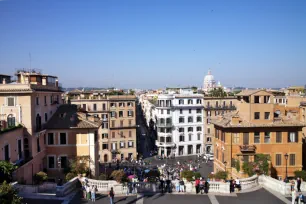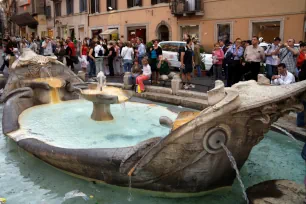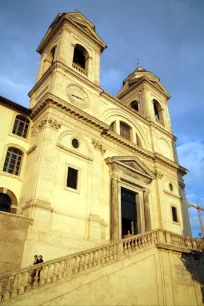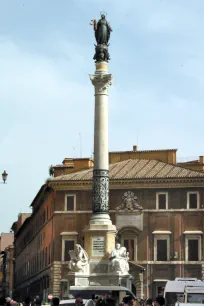The Piazza di Spagna is one of the most popular meeting places in Rome. It is also one of the most visually pleasing squares. The combination of a monumental staircase (the famous Spanish Steps), an obelisk and a beautiful church is a draw for tourists and photographers.

Spanish Steps

The Piazza di Spagna (Spanish Square) is connected to the Trinità dei Monti, a French church situated atop a hill, via a long staircase, the Scalinata della Trinità dei Monti, better known as the Spanish Steps. The idea of connecting the church with the square below originates from the seventeenth century, when the French also planned a statue of King Louis XIV of France at the top of the staircase.
Papal opposition caused the plans to be shelved until 1723, when the monumental staircase was built without the statue. Pope Innocent XIII appointed the Italian architect Francisco de Sanctis. He presented a design that satisfied both the French and the papacy.


The elegant staircase consists of 137 steps over twelve different flights. It has an irregular, albeit symmetric structure. It is especially beautiful in May, when it is decorated with flowering azaleas. The steps are usually very crowded; it attracts tourists as well as locals who use it as a gathering place.
Fontana della Barcaccia
In front of the Spanish Steps stands the Fontana della Barcaccia, a rather sober but elegant looking fountain commissioned by pope Urban VIII and designed by Gian Lorenzo Bernini.
Bernini’s design, which shows a flooded boat at the center of a basin, was inspired by the flooding of the Tiber in 1598, when a small boat stranded here after the water subsided.
Trinità dei Monti


The Trinità dei Monti is a beautiful French church located on a hill overlooking the small piazza della Trinità dei Monti. From this square, you have a nice view over the city. Its location on top of the Spanish Steps make the Trinità dei Monti a well-known landmark in Rome.
At the end of the fifteenth century, only a small chapel existed on the hill. In 1495, French King Louis XII commissioned the erection of a new church, replacing the chapel. Construction started in 1502 and dragged on for decades. It was only consecrated in 1585 by Pope Sixtus V.
The Gothic church with a Renaissance facade has two bell-towers. Inside, several paintings decorate the different chapels. Among them are two works by Daniele da Volterra, a pupil of Michelangelo.
The obelisk just in front of the church was originally located in the Gardens of Sallust. In 1788, it was moved to its current location on request of pope Pius VI. The hieroglyphs were copied from the obelisk on the Piazza del Popolo.
Colonna dell’Immacolata
In the southeast part of the square stands the Colonna dell’Immacolata (column of the immaculate conception). The column was found in 1777 underneath a monastery. It was erected here in 1857 to commemorate the dogma of the immaculate conception. It is now topped with a statue of Virgin Mary.
- Next: Piazza Navona
- More Sights & Attractions in Rome

